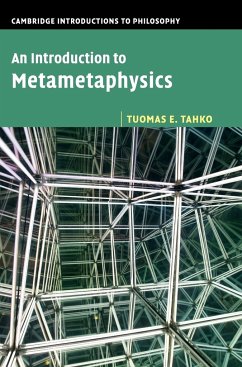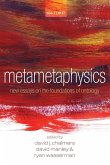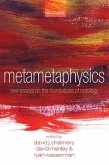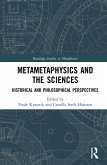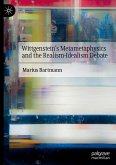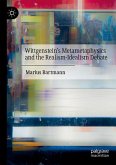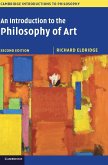Tuomas E. Tahko
An Introduction to Metametaphysics
Tuomas E. Tahko
An Introduction to Metametaphysics
- Gebundenes Buch
- Merkliste
- Auf die Merkliste
- Bewerten Bewerten
- Teilen
- Produkt teilen
- Produkterinnerung
- Produkterinnerung
This is the first systematic student introduction to metametaphysics, examining the nature, foundations and methodology of metaphysical inquiry.
Andere Kunden interessierten sich auch für
![Metametaphysics Metametaphysics]() David Chalmers / David Manley / Ryan Wasserman (ed.)Metametaphysics53,99 €
David Chalmers / David Manley / Ryan Wasserman (ed.)Metametaphysics53,99 €![Metametaphysics Metametaphysics]() David Chalmers / David Manley / Ryan Wasserman (ed.)Metametaphysics228,99 €
David Chalmers / David Manley / Ryan Wasserman (ed.)Metametaphysics228,99 €![Metametaphysics and the Sciences Metametaphysics and the Sciences]() Metametaphysics and the Sciences165,99 €
Metametaphysics and the Sciences165,99 €![Wittgenstein's Metametaphysics and the Realism-Idealism Debate Wittgenstein's Metametaphysics and the Realism-Idealism Debate]() Marius BartmannWittgenstein's Metametaphysics and the Realism-Idealism Debate100,99 €
Marius BartmannWittgenstein's Metametaphysics and the Realism-Idealism Debate100,99 €![Wittgenstein's Metametaphysics and the Realism-Idealism Debate Wittgenstein's Metametaphysics and the Realism-Idealism Debate]() Marius BartmannWittgenstein's Metametaphysics and the Realism-Idealism Debate139,09 €
Marius BartmannWittgenstein's Metametaphysics and the Realism-Idealism Debate139,09 €![An Introduction to the Philosophy of Art An Introduction to the Philosophy of Art]() Richard EldridgeAn Introduction to the Philosophy of Art101,99 €
Richard EldridgeAn Introduction to the Philosophy of Art101,99 €![An Introduction to Rights An Introduction to Rights]() William A. EdmundsonAn Introduction to Rights100,99 €
William A. EdmundsonAn Introduction to Rights100,99 €-
-
-
This is the first systematic student introduction to metametaphysics, examining the nature, foundations and methodology of metaphysical inquiry.
Hinweis: Dieser Artikel kann nur an eine deutsche Lieferadresse ausgeliefert werden.
Hinweis: Dieser Artikel kann nur an eine deutsche Lieferadresse ausgeliefert werden.
Produktdetails
- Produktdetails
- Verlag: Cambridge University Press
- Seitenzahl: 270
- Erscheinungstermin: 2. Juni 2016
- Englisch
- Abmessung: 250mm x 175mm x 19mm
- Gewicht: 650g
- ISBN-13: 9781107077294
- ISBN-10: 110707729X
- Artikelnr.: 43410289
- Herstellerkennzeichnung
- Libri GmbH
- Europaallee 1
- 36244 Bad Hersfeld
- gpsr@libri.de
- Verlag: Cambridge University Press
- Seitenzahl: 270
- Erscheinungstermin: 2. Juni 2016
- Englisch
- Abmessung: 250mm x 175mm x 19mm
- Gewicht: 650g
- ISBN-13: 9781107077294
- ISBN-10: 110707729X
- Artikelnr.: 43410289
- Herstellerkennzeichnung
- Libri GmbH
- Europaallee 1
- 36244 Bad Hersfeld
- gpsr@libri.de
Tuomas E. Tahko is a University Lecturer in Theoretical Philosophy and a Finnish Academy Research Fellow at the University of Helsinki. He is the editor of Contemporary Aristotelian Metaphysics (Cambridge, 2012) and author of numerous articles in journals, including Mind, The Philosophical Quarterly, Erkenntnis and Thought.
1. Why should you care about metametaphysics?
1.1. Metametaphysics or metaontology?
1.2. How to read this book
1.3. Chapter outlines
1.4. Further reading
2. Quine vs Carnap: on what there is and what there isn't
2.1. On what there is
2.2. Plato's beard
2.3. Enter Meinong
2.4. External and internal questions
2.5. Language pluralism
3. Quantification and ontological commitment
3.1. The meaning of the existential quantifier
3.2. The existential quantifier and ontological commitment
3.3. Quantifier variance and verbal debates
3.4. Beyond existence questions
4. Identifying the alternatives: ontological realism, deflationism, and conventionalism
4.1. Ontological realism and anti-realism
4.2. Ontological deflationism
4.3. Towards extreme conventionalism
4.4. A case study: Sider's ontological realism
4.5. Taking stock
5. Grounding and ontological dependence
5.1. Ontological dependence: a fine-grained notion
5.2. Identity-dependence and essential dependence
5.3. Is grounding ontological dependence?
5.4. Formal features of ground
5.5. Grounding, causation, reduction, and modality
5.6. Grounding and truthmaking
6. Fundamentality and levels of reality
6.1. The 'levels' metaphor
6.2. Mereological fundamentality
6.3. Further specifications: well-foundedness and dependence
6.4. Generic ontological fundamentality
6.5. Fundamentality and physics
7. The epistemology of metaphysics: a priori or a posteriori?
7.1. A priori vs a posteriori
7.2. Modal rationalism and a priori methods
7.3. The epistemology of essence
7.4. Modal empiricism and the status of armchair methods
7.5. Combining a priori and a posteriori methods
8. Intuitions and thought experiments in metaphysics
8.1. Specifying 'intuition'
8.2. Intuitions and experimental philosophy
8.3. Experience-based intuitions
8.4. Rational intuition
8.5. Scientific thought experiments
8.6. Philosophical thought experiments
9. Demarcating metaphysics and science: can metaphysics be naturalized?
9.1. Autonomous metaphysics
9.2. Fully naturalistic metaphysics
9.3. The Principle of Naturalistic Closure and the Primacy of Physics
9.4. Methodological similarities
9.5. Moderately naturalistic metaphysics
Glossary
Bibliography
Index.
1.1. Metametaphysics or metaontology?
1.2. How to read this book
1.3. Chapter outlines
1.4. Further reading
2. Quine vs Carnap: on what there is and what there isn't
2.1. On what there is
2.2. Plato's beard
2.3. Enter Meinong
2.4. External and internal questions
2.5. Language pluralism
3. Quantification and ontological commitment
3.1. The meaning of the existential quantifier
3.2. The existential quantifier and ontological commitment
3.3. Quantifier variance and verbal debates
3.4. Beyond existence questions
4. Identifying the alternatives: ontological realism, deflationism, and conventionalism
4.1. Ontological realism and anti-realism
4.2. Ontological deflationism
4.3. Towards extreme conventionalism
4.4. A case study: Sider's ontological realism
4.5. Taking stock
5. Grounding and ontological dependence
5.1. Ontological dependence: a fine-grained notion
5.2. Identity-dependence and essential dependence
5.3. Is grounding ontological dependence?
5.4. Formal features of ground
5.5. Grounding, causation, reduction, and modality
5.6. Grounding and truthmaking
6. Fundamentality and levels of reality
6.1. The 'levels' metaphor
6.2. Mereological fundamentality
6.3. Further specifications: well-foundedness and dependence
6.4. Generic ontological fundamentality
6.5. Fundamentality and physics
7. The epistemology of metaphysics: a priori or a posteriori?
7.1. A priori vs a posteriori
7.2. Modal rationalism and a priori methods
7.3. The epistemology of essence
7.4. Modal empiricism and the status of armchair methods
7.5. Combining a priori and a posteriori methods
8. Intuitions and thought experiments in metaphysics
8.1. Specifying 'intuition'
8.2. Intuitions and experimental philosophy
8.3. Experience-based intuitions
8.4. Rational intuition
8.5. Scientific thought experiments
8.6. Philosophical thought experiments
9. Demarcating metaphysics and science: can metaphysics be naturalized?
9.1. Autonomous metaphysics
9.2. Fully naturalistic metaphysics
9.3. The Principle of Naturalistic Closure and the Primacy of Physics
9.4. Methodological similarities
9.5. Moderately naturalistic metaphysics
Glossary
Bibliography
Index.
1. Why should you care about metametaphysics?
1.1. Metametaphysics or metaontology?
1.2. How to read this book
1.3. Chapter outlines
1.4. Further reading
2. Quine vs Carnap: on what there is and what there isn't
2.1. On what there is
2.2. Plato's beard
2.3. Enter Meinong
2.4. External and internal questions
2.5. Language pluralism
3. Quantification and ontological commitment
3.1. The meaning of the existential quantifier
3.2. The existential quantifier and ontological commitment
3.3. Quantifier variance and verbal debates
3.4. Beyond existence questions
4. Identifying the alternatives: ontological realism, deflationism, and conventionalism
4.1. Ontological realism and anti-realism
4.2. Ontological deflationism
4.3. Towards extreme conventionalism
4.4. A case study: Sider's ontological realism
4.5. Taking stock
5. Grounding and ontological dependence
5.1. Ontological dependence: a fine-grained notion
5.2. Identity-dependence and essential dependence
5.3. Is grounding ontological dependence?
5.4. Formal features of ground
5.5. Grounding, causation, reduction, and modality
5.6. Grounding and truthmaking
6. Fundamentality and levels of reality
6.1. The 'levels' metaphor
6.2. Mereological fundamentality
6.3. Further specifications: well-foundedness and dependence
6.4. Generic ontological fundamentality
6.5. Fundamentality and physics
7. The epistemology of metaphysics: a priori or a posteriori?
7.1. A priori vs a posteriori
7.2. Modal rationalism and a priori methods
7.3. The epistemology of essence
7.4. Modal empiricism and the status of armchair methods
7.5. Combining a priori and a posteriori methods
8. Intuitions and thought experiments in metaphysics
8.1. Specifying 'intuition'
8.2. Intuitions and experimental philosophy
8.3. Experience-based intuitions
8.4. Rational intuition
8.5. Scientific thought experiments
8.6. Philosophical thought experiments
9. Demarcating metaphysics and science: can metaphysics be naturalized?
9.1. Autonomous metaphysics
9.2. Fully naturalistic metaphysics
9.3. The Principle of Naturalistic Closure and the Primacy of Physics
9.4. Methodological similarities
9.5. Moderately naturalistic metaphysics
Glossary
Bibliography
Index.
1.1. Metametaphysics or metaontology?
1.2. How to read this book
1.3. Chapter outlines
1.4. Further reading
2. Quine vs Carnap: on what there is and what there isn't
2.1. On what there is
2.2. Plato's beard
2.3. Enter Meinong
2.4. External and internal questions
2.5. Language pluralism
3. Quantification and ontological commitment
3.1. The meaning of the existential quantifier
3.2. The existential quantifier and ontological commitment
3.3. Quantifier variance and verbal debates
3.4. Beyond existence questions
4. Identifying the alternatives: ontological realism, deflationism, and conventionalism
4.1. Ontological realism and anti-realism
4.2. Ontological deflationism
4.3. Towards extreme conventionalism
4.4. A case study: Sider's ontological realism
4.5. Taking stock
5. Grounding and ontological dependence
5.1. Ontological dependence: a fine-grained notion
5.2. Identity-dependence and essential dependence
5.3. Is grounding ontological dependence?
5.4. Formal features of ground
5.5. Grounding, causation, reduction, and modality
5.6. Grounding and truthmaking
6. Fundamentality and levels of reality
6.1. The 'levels' metaphor
6.2. Mereological fundamentality
6.3. Further specifications: well-foundedness and dependence
6.4. Generic ontological fundamentality
6.5. Fundamentality and physics
7. The epistemology of metaphysics: a priori or a posteriori?
7.1. A priori vs a posteriori
7.2. Modal rationalism and a priori methods
7.3. The epistemology of essence
7.4. Modal empiricism and the status of armchair methods
7.5. Combining a priori and a posteriori methods
8. Intuitions and thought experiments in metaphysics
8.1. Specifying 'intuition'
8.2. Intuitions and experimental philosophy
8.3. Experience-based intuitions
8.4. Rational intuition
8.5. Scientific thought experiments
8.6. Philosophical thought experiments
9. Demarcating metaphysics and science: can metaphysics be naturalized?
9.1. Autonomous metaphysics
9.2. Fully naturalistic metaphysics
9.3. The Principle of Naturalistic Closure and the Primacy of Physics
9.4. Methodological similarities
9.5. Moderately naturalistic metaphysics
Glossary
Bibliography
Index.

